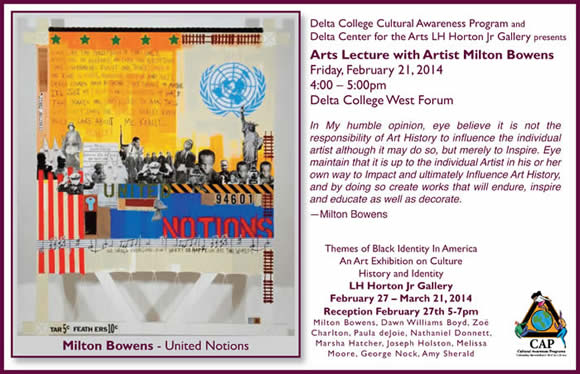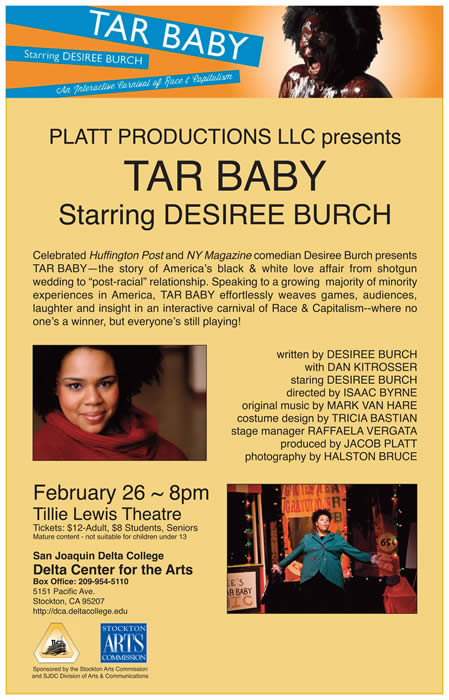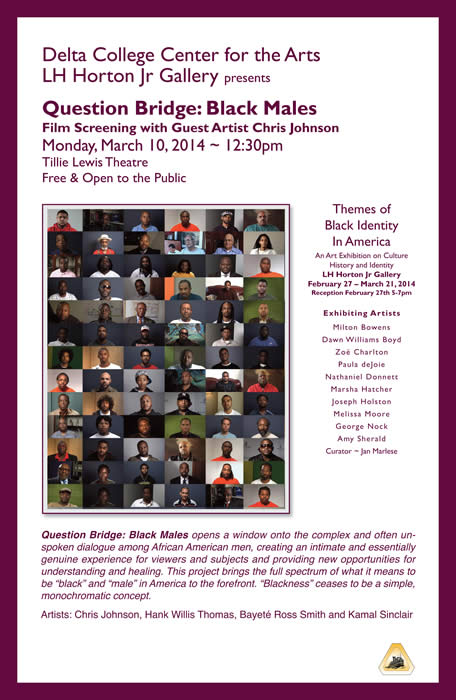 |
Milton Bowens
Kinfolk
mixed media on canvas
with alphabet blocks and rope
30" x 41"
2011
$5,000
Artist Statement(abbreviated)
My paintings focus on the interplay between past and present, time, place and truth, between joy and pain, also between different forms of tolerance, activism and under-standing. My works pair the legacy and importance of maintaining self-esteem for African Americans while examining the importance of controlling the cultural narrative of one’s own stories and experiences. (link to full Statement/Bio)
Artist website link
|
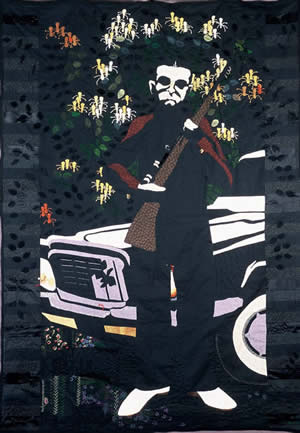 |
Dawn Williams Boyd
Waiting for Medgar:
Jackson, MS 1963
cotton fabrics and floss, bugle beads, sequins
80" x 56.5"
2004
$3,960
Artist Statement (abbreviated)
Meticulous drawing, precise machine stitches, voluptuous hand embroidery and beading are merged with the ‘womanly’ art of fabric manipulation. This piece is part of my Sins of the Fathers series, which consists of over 20 pieces in cloth, acrylic paints and oven fired clay, that depict sometimes little known stories of racial injustice and violence against America’s Black citizens. This represents the story of Medgar Wiley Evers, who was brutally murdered by admitted white supremacist Byron De La Beckwith. (link to full Statement/Bio)
Artist website link |
 |
Zoë Charlton &
Melissa Moore
Cleveland Marches to the
White House
animation video - click to play
2007
?Cleveland Marches to the White House was inspired by Henry Ossawa Tanner’s painting (below), called
The Banjo Lesson (1893), and uses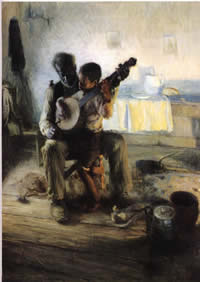
the painting as backdrop and content for the animation. In the referenced painting, an older man instructs a young boy how to play the banjo. In CMWH, the older man has been animated—he blinks, nods his head, and moves his head/foot to the music. The child sitting on his lap has been substituted with an adult woman. She’s sitting on ‘grandpa’s’ knee, but instead of learning to play the banjo, she easily strums a tune that becomes progressively intricate and muddled through overlapping recordings of the song. The audio is a rendition of “Cleveland’s Marching to the White House” by Bertie Mae Dickens, an old time, North Carolina banjo player.
Zoë Charlton website link
Melissa Moore website link
(link to Statement Bios) |
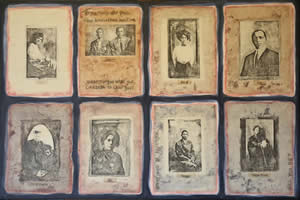
Click here for larger view
|
Paula deJoie
To All Those Who Think
photo image transfer, collage
20" x 24"
2003
NFS
Artist Statement (abbreviated)
This image was inspired by overhearing Bay Area teenagers speaking to each other in language that I found to be degrading and insulting. I felt that they wouldn't call each other these names if they knew more of their history...if they knew that their ancestors died so that we could all receive an education and that they carried themselves with dignity and grace. This image depicts photos of the 1911 graduating class of Philander Smith College in Little Rock, Arkansas contrasted with the "n" and "b" labels I hear too much of. (link to full Statement/Bio)
Artist website link |
 |
Nathaniel Donnett
miniscule, mini-school, i meant two schools; keep watching
conte, graphite, color pencil, plastic on paper bags
51" x 53"
2012
price on request
Artist Statement (abbreviated)
This piece reflects on a multiple thought response to power, authoritative positions and institutions that direct and control society. Inspired by the film 1984, which was created from George Orwell’s book 1984 and the rapper Jay Z’s song “The Streets Are Watching” made me think about the question of who patrols those who are in power to patrol us? Security cameras can make you feel safe and also like a criminal. It was the video camera that caught those police in action beating Rodney King. It is the camera that that can cause one to feel their privacy is being reduced. How could one turn the cameras back on them? How could one be placed in a position to be the authority over the authority, educate the educators? I was thinking about relearning, reclaiming our human rights that seem to be slipping away. (link to full Statement/Bio)
Artist website link |
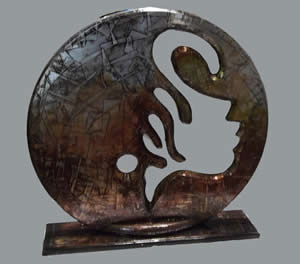
|
Marsha Hatcher
Diaspora
wood, aluminum, resin
24"
2013
$750
Artist Statement (abbreviated)
Diaspora: A dispersion of a people from their original homeland. This sculpture is intended to be viewed as an abstract however, the image of the woman can be clearly seen when the negative space (the cut out area) is the focal point. I choose a woman for this particular piece because of the significant role women had to play in the past. Women, men and children were taken from the only home they had ever known, stripped of their identity and were expected to conform to a new and unfamiliar society. The wood that makes up the majority of the material lies just beneath the surface of a very thin layer of aluminum.
(link to full Statement/Bio)
Artist website link
|
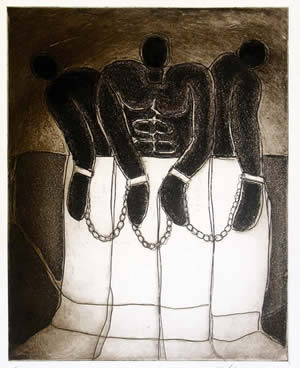 |
Joseph Holston
Color in Freedom:
Journey Along the Underground Railroad Subjugation
Artist's Proof IX/X
Hard Ground, Aquatint Etching
on Somerset Paper
Plate Size: 14" x 11"
2008
$1,500
Artist Statement (abbreviated)
Color in Freedom: Journey along the Underground Railroad, is included in the collection of the Library of Congress Fine Print Collection. The series was exhibited in 2010 at the United Nations in Geneva, Switzerland, and is also the recipient of a grant from the National Endowment for the Humanities. This visual narrative chronicles specific events of the African slave trade, from captivity and slavery, through escape and emancipation.
(link to full Statement/Bio)
Artist website link |
 |
George Nock
Alonzo Clayton
bronze
15"
$4,500
Artist Statement (abbreviated)
The story encompasses the forgotten first "Great Sports Stars" of America, the "Great Black Jockeys". The diminutive athletes who became giants in sports lore and history made their mark in being a part of America's great athletic heritage. Long before the three J's-Jackie Robinson, Joe Louis, and Jack Johnson broke the color barriers, these men and women were doing it in the Sport of Kings, namely horse racing. (Curator's note: excerpt from "The Kentucky Derby's Forgotten Black Jockeys," By Christopher Klein:
"By 1904, Black jockeys had been virtually banned from the major racetracks... Black participation dwindled, and no African-American rode the race between 1921 and 2000, when Marion St. Juilien guided Curule to a seventh place finish.")
(link to full Statement/Bio)
Artist website link
|
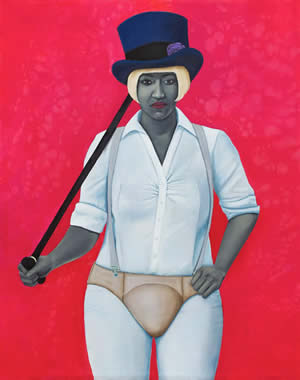 |
Amy Sherald
Madam Noire
oil on canvas
54" x 43"
2011
price on request
Artist Statement (abbreviated)
My paintings originated as a creation of a fairytale, illustrating an alternate existence in response to a dominant narrative of black history. As my ideas became more legible the use of fantasy evolved into scenes of spectacle (e.g. circuses), to make direct reference to blackness and racialization. Madame Noire posits the question: what is it like to be something other than the pre-scripted self that we know? The painting is engaged by way of fantasy and/or costume the idea of stepping out of a marginalized identity into one that is either self-created or an impersona-tion of another.
(link to full Statement/Bio)
Artist website link
|









